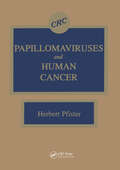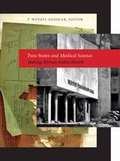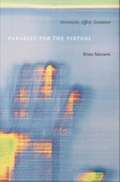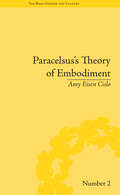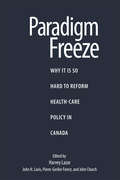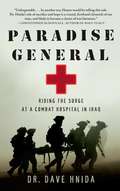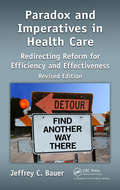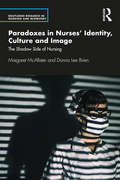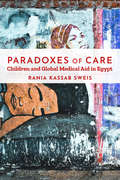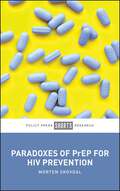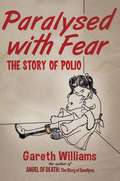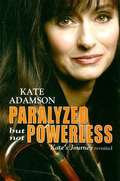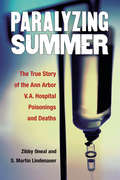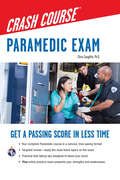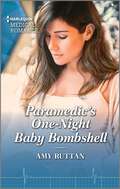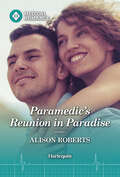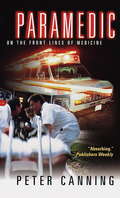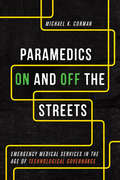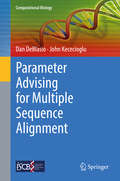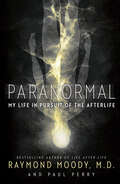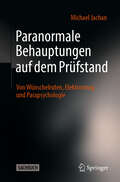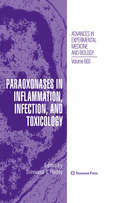- Table View
- List View
Papillomaviruses and Human Cancer
by Herbert PfisterThis volume gives special reference to papillomaviruses in benign precursor lesions related to genital tumors, plus it provides a basis for a more reproducible evaluation of the pathology of papillomavirus-induced lesions. It deals with the molecular biology of papillomaviruses as it relates to our understanding of viral cell transformation and malignant conversion. Written in a comprehensive, easy-to-read format, this book covers points of medical interest such as diagnosis, therapy, and prospects for vaccination. This fascinating text provides current, state-of-the-art practices for immediate and future medical research. Virologists, microbiologists, and cancer researchers will find this work interesting and resourceful.
Para-States and Medical Science: Making African Global Health
by Paul Wenzel GeisslerIn Para-States and Medical Science, P. Wenzel Geissler and the contributors examine how medicine and public health in Africa have been transformed as a result of economic and political liberalization and globalization, intertwined with epidemiological and technological changes. The resulting fragmented medical science landscape is shaped and sustained by transnational flows of expertise and resources. NGOs, universities, pharmaceutical companies and other nonstate actors now play a significant role in medical research and treatment. But as the contributors to this volume argue, these groups have not supplanted the primacy of the nation-state in Africa. Although not necessarily stable or responsive, national governments remain crucial in medical care, both as employers of health care professionals and as sources of regulation, access, and - albeit sometimes counterintuitively - trust for their people. "The state" has morphed into the "para-state" -- not a monolithic and predictable source of sovereignty and governance, but a shifting, and at times ephemeral, figure. Tracing the emergence of the "global health" paradigm in Africa in the treatment of HIV, malaria, and leprosy, this book challenges familiar notions of African statehood as weak or illegitimate by elaborating complex new frameworks of governmentality that can be simultaneously functioning and dysfunctional.Contributors. Uli Beisel, Didier Fassin, P. Wenzel Geissler, Rene Gerrets, Ann Kelly, Guillaume Lachenal, John Manton, Lotte Meinert, Vinh-Kim Nguyen, Branwyn Poleykett, Susan Reynolds Whyte
Parables for the Virtual: Movement, Affect, Sensation
by Brian MassumiAlthough the body has been the focus of much contemporary cultural theory, the models that are typically applied neglect the most salient characteristics of embodied existence--movement, affect, and sensation--in favor of concepts derived from linguistic theory. In Parables for the Virtual Brian Massumi views the body and media such as television, film, and the Internet, as cultural formations that operate on multiple registers of sensation beyond the reach of the reading techniques founded on the standard rhetorical and semiotic models. Renewing and assessing William James's radical empiricism and Henri Bergson's philosophy of perception through the filter of the post-war French philosophy of Deleuze, Guattari, and Foucault, Massumi links a cultural logic of variation to questions of movement, affect, and sensation. If such concepts are as fundamental as signs and significations, he argues, then a new set of theoretical issues appear, and with them potential new paths for the wedding of scientific and cultural theory. Replacing the traditional opposition of literal and figural with new distinctions between stasis and motion and between actual and virtual, Parables for the Virtual tackles related theoretical issues by applying them to cultural mediums as diverse as architecture, body art, the digital art of Stelarc, and Ronald Reagan's acting career. The result is an intriguing combination of cultural theory, science, and philosophy that asserts itself in a crystalline and multi-faceted argument. Parables for the Virtual will interest students and scholars of continental and Anglo-American philosophy, cultural studies, cognitive science, electronic art, digital culture, and chaos theory, as well as those concerned with the "science wars" and the relation between the humanities and the sciences in general.
Paracelsus's Theory of Embodiment: Conception and Gestation in Early Modern Europe ("The Body, Gender and Culture" #2)
by Amy Eisen CisloParacelsus has been called the father of modern chemistry and is legendary for his treatment of syphilis. This work argues that Paracelsus developed an understanding of the body as composed of two distinct sexes, revolutionizing early modern conceptions of the female body as an inversion of or flawed approximation of the male body.
Paradigm Freeze: Why It Is So Hard to Reform Health Care in Canada
by John N Lavis John Church Harvey Lazar Pierre-Gerlier ForestWhy has health care reform proved a stumbling block for provincial governments across Canada? What efforts have been made to improve a struggling system, and how have they succeeded or failed? In Paradigm Freeze, experts in the field answer these fundamental questions by examining and comparing six essential policy issues - regionalization, needs-based funding, alternative payment plans, privatization, waiting lists, and prescription drug coverage - in five provinces. Noting hundreds of recommendations from dozens of reports commissioned by provincial governments over the last quarter century - the great majority to little or no avail - the book focuses on careful diagnosis, rather than unplanned treatment, of the problem. Paradigm Freeze is based on thirty case studies of policy reform in Alberta, Saskatchewan, Ontario, Quebec, and Newfoundland and Labrador. The contributors assess the nature and extent of healthcare reform in Canada since the beginning of the 1990s. They account for the generally limited extent of reform that has occurred, and identify the factors associated with the relatively few cases of large reform. An insightful new perspective on a problem that has plagued Canadian governments for decades, Paradigm Freeze is an important addition to the field of health policy. Contributors include John Church (University of Alberta), Michael Ducie (Alberta Health and Wellness), Pierre-Gerlier Forest (Pierre Elliott Trudeau Foundation), Stephen Tomblin (Memorial University), Jeff Braun Jackson (Ontario Professional Firefighters Association, Burlington, ON), Marie-Pascale Pomey (Université de Montréal), John N. Lavis (McMaster University), Harvey Lazar (Queen's University), Elisabeth Martin (Université Laval),Tom McIntosh (University of Regina), Dianna Pasic (McMaster University), Neale Smith (University of British Columbia), and Michael G. Wilson (McMaster University).
Paradigm Freeze: Why It Is So Hard to Reform Health Care in Canada (Queen's Policy Studies Series #179)
by John Church Harvey Lazar Pierre-Gerlier Forest John N. LavisWhy has health care reform proved a stumbling block for provincial governments across Canada? What efforts have been made to improve a struggling system, and how have they succeeded or failed? In Paradigm Freeze, experts in the field answer these fundamental questions by examining and comparing six essential policy issues - regionalization, needs-based funding, alternative payment plans, privatization, waiting lists, and prescription drug coverage - in five provinces. Noting hundreds of recommendations from dozens of reports commissioned by provincial governments over the last quarter century - the great majority to little or no avail - the book focuses on careful diagnosis, rather than unplanned treatment, of the problem. Paradigm Freeze is based on thirty case studies of policy reform in Alberta, Saskatchewan, Ontario, Quebec, and Newfoundland and Labrador. The contributors assess the nature and extent of healthcare reform in Canada since the beginning of the 1990s. They account for the generally limited extent of reform that has occurred, and identify the factors associated with the relatively few cases of large reform. An insightful new perspective on a problem that has plagued Canadian governments for decades, Paradigm Freeze is an important addition to the field of health policy. Contributors include John Church (University of Alberta), Michael Ducie (Alberta Health and Wellness), Pierre-Gerlier Forest (Pierre Elliott Trudeau Foundation), Stephen Tomblin (Memorial University), Jeff Braun Jackson (Ontario Professional Firefighters Association, Burlington, ON), Marie-Pascale Pomey (Université de Montréal), John N. Lavis (McMaster University), Harvey Lazar (Queen's University), Elisabeth Martin (Université Laval),Tom McIntosh (University of Regina), Dianna Pasic (McMaster University), Neale Smith (University of British Columbia), and Michael G. Wilson (McMaster University).
Paradise General: Riding the Surge at a Combat Hospital in Iraq
by Dave HnidaIN 2004, AT THE AGE OF FORTY-EIGHT, DR. DAVE HNIDA, a family physician from Littleton, Colorado, volunteered to be deployed to Iraq and spent a tour of duty as a battalion surgeon with a combat unit. In 2007, he went back--this time as a trauma chief at one of the busiest Combat Support Hospitals (CSH) during the Surge. In an environment that was nothing less than a modern-day M*A*S*H, the doctors' main objective was simple: Get 'em in, get 'em out. The only CSH staffed by reservists-- who tended to be older, more-experienced doctors disdainful of authority--the 399th soon became a medevac destination of choice because of its high survival rate, an astounding 98 percent. This was fast-food medicine at its best: working in a series of tents connected to the occasional run-down building, Dr. Hnida and his fellow doctors raced to keep the wounded alive until they could be airlifted out of Iraq for more extensive repairs. Here the Hippocratic Oath superseded that of the pledge to Uncle Sam; if you got the red-carpet helicopter ride, his team took care of you, no questions asked. On one stretcher there might be a critically injured American soldier while three feet away lay the insurgent, shot in the head, who planted the IED that inflicted those wounds. But there was levity amid the chaos. On call round-the-clock with an unrelenting caseload, the doctors' prescription for sanity included jokes, pranks, and misbehavior. Dr. Hnida's deployment was filled with colorful characters and gifted surgeons, a diverse group who became trusted friends as together they dealt with the psychological toll of seeing the casualties of war firsthand. In a conflict with no easy answers and even less good news, Paradise General gives us something that we can all believe in--the story of an ordinary citizen turned volunteer soldier trying to make a difference. With honesty and candor, and an off-the-wall, self-deprecating humor that sustained him and his battle buddies through their darkest hours, Dr. Hnida delivers a devastating and inspiring account of his CSH tour and an unparalleled look at medical care during an unscripted war.
Paradox and Imperatives in Health Care: Redirecting Reform for Efficiency and Effectiveness, Revised Edition
by Drummer Steven B. Olaf Jeffrey C. BauerThe Paradox: Americans are not as healthy as people in dozens of comparable countries that spend 30 percent less on health care, and our medical marketplace overall is plagued by persistent problems of cost, quality, and access. Yet, the worlds best individual health systems are located in the U.S.each a unique result of visionary leadership and
Paradoxes in Nurses’ Identity, Culture and Image: The Shadow Side of Nursing (Routledge Research in Nursing and Midwifery)
by Margaret McAllister Donna Lee BrienThis book examines some of the more disturbing representations of nurses in popular culture, to understand nursing’s complex identities, challenges and future directions. It critically analyses disquieting representations of nurses who don’t care, who kill, who inspire fear or who do not comply with laws and policies. Also addressed are stories about how power is used, as well as supernatural experiences in nursing. Using a series of examples taken from popular culture ranging from film, television and novels to memoirs and true crime podcasts, it interrogates the meaning of the shadow side of nursing and the underlying paradoxes that influence professional identity. Iconic nursing figures are still powerful today. Decades after they were first created, Ratched and Annie Wilkes continue to make readers and viewers shudder at the prospect of ever being ill. Modern storytelling modes are bringing to audiences the grim reality that some nurses are members of the working poor, like Cath Hardacre in Trust Me, and others can be dangerous con artists, like the nurse in Dirty John. This book is important reading for all those interested in understanding the links between nursing’s image and the profession’s potential as an agent for change.
Paradoxes of Care: Children and Global Medical Aid in Egypt (Stanford Studies in Middle Eastern and Islamic Societies and Cultures)
by Rania Kassab SweisEach year, billions of dollars are spent on global humanitarian health initiatives. These efforts are intended to care for suffering bodies, especially those of distressed children living in poverty. But as global medical aid can often overlook the local economic and political systems that cause bodily suffering, it can also unintentionally prolong the very conditions that hurt children and undermine local aid givers. Investigating medical humanitarian encounters in Egypt, Paradoxes of Care illustrates how child aid recipients and local aid experts grapple with global aid's shortcomings and its paradoxical outcomes. Rania Kassab Sweis examines how some of the world's largest aid organizations care for vulnerable children in Egypt, focusing on medical efforts with street children and out-of-school village girls. Her in-depth ethnographic study reveals how global medical aid fails to "save" these children according to its stated aims, and often maintains—or produces new—social disparities in children's lives. Foregrounding vulnerable children's responses to medical aid, Sweis moves past the unquestioned benevolence of global health to demonstrate how children must manage their own bodies and lives in the absence of adult care. With this book, she challenges readers to engage with the question of what medical caregivers and donors alike gain from such global humanitarian transactions.
Paradoxes of PrEP for HIV Prevention
by Morten SkovdalAvailable open access digitally under CC-BY licence. Pre-exposure prophylaxis (PrEP) is a drug taken by HIV-negative people that reduces the risk of getting HIV. Comparing two case studies in Denmark and Zimbabwe, this book demonstrates six paradoxes that users often encounter in navigating their PrEP journey. These paradoxes lead to contentions, uncertainties, dilemmas and ambiguities that need to be carefully and pensively responded to through what the author terms ‘everyday PrEP negotiations’. The social nature and need for such everyday PrEP negotiations help explain why PrEP works for some people and not for others. This book argues that such insight is critical to make PrEP work for more people and to inform social public health responses.
Paralysed with Fear
by Gareth WilliamsFrom the award-winning author ofAngel of Death comes a comprehensive and engaging narrative of mankind's battle against polio. For much of the twentieth century, polio inspired terror as the 'morning paralysis' which could invade any home and disable or kill a previously healthy person. The cruelty of the disease is epitomised by the iconic images of the crippled child and the iron lung. This is the story of mankind's struggle against polio, is compelling, exciting and full of twists and pardoxes. One of the grand challenges of modern medicine, it was a battleground between good and bad science. Some research won Nobel Prizes; other work was flawed or fraudulent, holding up progress and endangering patients' lives. Gareth Williams takes an original view of the journey to understanding and defeating polio, exploring the profoundly moving experiences of victims alongside the medical and scientific landmarks in the history of the disease. Praise forAngel of Death: 'An engaging narrative, in which medical history is interweaved with social history and reflections on contemporary issues'BBC History Magazine 'Wonderful. Wonderfully-researched, vividly-written, an example of medical history at its absolute best. ' Michael Neve
Paralyzed But Not Powerless: Kate's Journey Revisited
by Kate AdamsonKate's Journey is a touching story of a woman's survival and recovery from a double brain-stem stroke. The book provides information on the warning signs of stroke and teaches us how to meet life threatening challenges with grace and valor. Kate's determination, humor and wisdom are inspiring. Her lessons are a model for anyone who struggles with a terminal illness to reach beyond the pain and fear to over come and celebrate life.
Paralyzing Summer: The True Story of the Ann Arbor V.A. Hospital Poisonings and Deaths
by Elizabeth Oneal S. Martin LindenauerIn the summer of 1975, an alarming number of patients at the Ann Arbor Veterans Administration Hospital began experiencing mysterious respiratory failures that left ten dead and over thirty more clinging to life. Doctors struggled to determine the cause of the attacks, and further analysis revealed each of the victims' intravenous drip bags had been contaminated with a powerful muscle relaxant named Pavulon--a drug traditionally used in hospitals when inserting patient breathing tubes in preparation for surgery. The discovery of Pavulon was particularly disturbing because hospital safeguards made it unlikely the chemical had been introduced to patients' drip bags by mistake. This suggested deliberate poisoning, but with no apparent connection between the victims, the motive behind the crime was unclear. The tangled investigation that followed gripped the nation's attention, particularly after the FBI narrowed its focus to two improbable suspects: a pair of well-liked nurses from the hospital's intensive care unit. Both were of Filipino decent, and the national media speculated racism was a major factor in the scrutiny placed on the nurses. Drawing extensively from court documents, news coverage from the time, and interviews with participants, Zibby Oneal and S. Martin Lindenauer's Paralyzing Summer presents a gripping account of the baffling case, following the incredible twists and turns that unfolded over a two and a half year period starting July 1975.
Paramedic Crash Course with Online Practice Test
by Christopher CoughlinREA’s Paramedic Crash Course®Everything You Need for the Exam – in a Fast Review Format!From the Author of REA’s Best-selling EMT Crash Course®REA’s Paramedic Crash Course® is the only book of its kind for the last-minute studier or any prospective Paramedic who wants a quick refresher before taking the National Registry Paramedic (NRP) Exam.Targeted, Focused Review – Study Only What You Need to Know Written by Dr. Christopher Coughlin, an EMS Program Director and paramedic with 27 years of experience, Paramedic Crash Course® relies on the author’s careful analysis of the exam’s content and actual test questions. It covers only the information tested on the exam, so you can make the most of your valuable study time. Our fully indexed targeted review covers all the official test categories including airway and breathing, medical emergencies, trauma, special patients, and EMS operations.Expert Test-taking Strategies Our experienced author explains the structure of the exam, so you know what to expect on test day. He also shares detailed question-level strategies and shows you the best way to answer questions. By following our expert tips and advice, you can score higher on every section of the exam.Full-length Online Practice Exam The book comes with a true-to-format online practice test with diagnostic feedback, topic-level scoring, and detailed answer explanations to help students gauge their test-readiness.No matter how or when you prepare for the Paramedic Exam, REA’s Paramedic Crash Course® will show you how to study efficiently and strategically, so you can get a great score!
Paramedic's Fling to Forever
by Sue MacKayIn Sue MacKay&’s latest medical romance, a temporary fling becomes complicated when the doctor becomes her new colleague… IT STARTED ONE WEEK IN BRISBANE… Paramedic Leesa&’s instant attraction to Dr. Nick while at a party is overwhelming and irresistible! Five days of fun is just what the doctor ordered—and all they can offer emotionally. But fate has other ideas when Nick takes a permanent job where Leesa works. Suddenly, there&’s no avoiding each other! And resuming their fling is inevitable… Yet, having been burned by difficult marriages, will they have the courage to take a chance on forever? From Harlequin Medical: Life and love in the world of modern medicine.
Paramedic's One-Night Baby Bombshell
by Amy RuttanIn the latest Harlequin Medical Romance by Amy Ruttan, an uncharacteristic one-night stand leads to an unexpected consequence for the doctor and the paramedic. But could their baby be the answer to their broken hearts? Can an unexpected baby… …heal two broken hearts? Widow Dr. Jo York seizes the chance to escape to a small island town. That&’s adventurous enough, but her uncharacteristic one-night stand with gorgeous paramedic Henrik exceeds expectations! And so do the consequences… Jo has always dreamed of being a mother, but never thought she&’d have children. If discovering she&’s pregnant rocks her well-ordered world, what will it do to guarded, no-strings Henrik when she tells him, I&’m pregnant. And the baby&’s yours…?From Harlequin Medical: Life and love in the world of modern medicine.
Paramedic's Reunion in Paradise
by Alison RobertsIn Alison Roberts&’s latest Harlequin Medical Romance, volunteering at Reki Island Children&’s Camp is one paramedic&’s idea of paradise…until the doctor who broke her heart signs up, too! A RISK WORTH TAKING…AGAIN? Paramedic and adrenaline junkie Maya treasures volunteering at Reki Island Children&’s Camp. But a reunion with her ex, the camp&’s latest recruit, was not on the agenda! It&’s been a decade since Dr. Eli broke her heart, yet their attraction reignites with just one glance… Which is very inconvenient, because the losses Eli&’s faced have made him more cautious and guarded than ever. Despite their differences and the echoes of old pain between them, Maya&’s soon reminded why she first fell for Eli. Trapped in paradise, could this be their sun-soaked second chance?From Harlequin Medical: Life and love in the world of modern medicine.
Paramedic: On the Front Lines of Medicine
by Peter CanningIn this unforgettable, dramatic account of one man's experience as an EMT, Peter Canning relives the nerve-racking seconds that can mean the difference between a patient's death and survival, as Canning struggles to make the right call, dispense the right medication, or keep a patient's heart beating long enough to reach the hospital. As Canning tells his graphic, gripping war stories--of the lives he saved and lost; of the fear, the nightmares, and the constant adrenaline-pumping thrill of action--we come away with an unforgettable portrait of what it means to be a hero.
Paramedics On and Off the Streets: Emergency Medical Services in the Age of Technological Governance
by Michael K. CormanIn Paramedics On and Off the Streets, Michael K. Corman embarks on an institutional ethnography of the complex, mundane, intricate, and exhilarating work of paramedics in Calgary, Alberta. Corman’s comprehensive research includes more than 200 hours of participant observation ride-alongs with paramedics over a period of eleven months, more than one hundred first hand interviews with paramedics, and thirty-six interviews with other emergency medical personnel including administrators, call-takers and dispatchers, nurses, and doctors. At the heart of this ethnography are questions about the role of paramedics in urban environments, the role of information and communication technologies in contemporary health care governance, and the organization and accountability of pre-hospital medical services. Paramedics On and Off the Streets is the first institutional ethnography to explore the role and increasing importance of paramedics in our healthcare system. It takes readers on a journey into the everyday lives of EMS personnel and provides an in-depth sociological analysis of the work of pre-hospital health care professionals in the twenty-first century.
Parameter Advising for Multiple Sequence Alignment
by Dan DeBlasio John KececiogluThis book develops a new approach called parameter advising for finding a parameter setting for a sequence aligner that yields a quality alignment of a given set of input sequences. In this framework, a parameter advisor is a procedure that automatically chooses a parameter setting for the input, and has two main ingredients: (a) the set of parameter choices considered by the advisor, and (b) an estimator of alignment accuracy used to rank alignments produced by the aligner. On coupling a parameter advisor with an aligner, once the advisor is trained in a learning phase, the user simply inputs sequences to align, and receives an output alignment from the aligner, where the advisor has automatically selected the parameter setting. The chapters first lay out the foundations of parameter advising, and then cover applications and extensions of advising. The content * examines formulations of parameter advising and their computational complexity, * develops methods for learning good accuracy estimators, * presents approximation algorithms for finding good sets of parameter choices, and * assesses software implementations of advising that perform well on real biological data. Also explored are applications of parameter advising to * adaptive local realignment, where advising is performed on local regions of the sequences to automatically adapt to varying mutation rates, and * ensemble alignment, where advising is applied to an ensemble of aligners to effectively yield a new aligner of higher quality than the individual aligners in the ensemble. The book concludes by offering future directions in advising research.
Paranoia: The madness that makes history
by Luigi ZojaLuigi Zoja presents an insightful analysis of the use and misuse of paranoia throughout history and in contemporary society. Zoja combines history with depth psychology, contemporary politics and tragic literature, resulting in a clear and balanced analysis presented with rare clarity. The devastating impact of paranoia on societies is explored in detail. Focusing on the contagious aspects of paranoia and its infectious, self-replicating dynamics, Zoja takes such diverse examples as Ajax and George W. Bush, Cain and the American Holocaust, Hitler, Stalin and Othello to illustrate his argument. He reconstructs the emblematic arguments that paranoia has promoted in Western history and examines how the power of the modern media and mass communication has affected how it spreads. Paranoia clearly examines how leaders lose control of their influence, how the collective unconscious acquires an autonomous life and how seductive its effects can be - more so than any political, religious or ideological discourse. This gripping study will be essential reading for depth and analytical psychologists, and academics and students of history, cultural studies, psychology, classical studies, literary studies, anthropology and sociology.
Paranormal: My Life in Pursuit of the Afterlife
by Paul Perry Raymond MoodyThe author of Life After Life present a look at his life spent researching near-death experiences in this fascinating memoir.Paranormal begins with a harrowing account of Moody’s suicide attempt—due to an undiagnosed illness that led him into depression—and proceeds to explore his lifelong fascination with life beyond our bodies. Moody traces the roots of his obsession with the point of death and how, at age twenty-three, he launched the entirely new medical field of near-death studies. He went on to explore the world of past lives and possible reincarnation before stumbling into the fascinating realm of facilitated visions. Moody’s rural research center, Theater of the Mind, dramatically advances paranormal research by melding ancient and modern techniques to arouse many of the transformative elements of the near-death experience in people who are still living.After more than four decades of studying death and the possibility of an afterlife, Moody still sees endless promise in the fringes of psychological sciences, where he continues to seek answers to what happens to our souls after death.Praise for Paranormal“A lucid, engrossing memoir from a psychologist and philosopher dedicated to the afterlife. . . . The fascinating life story of an impassioned mystical maverick.” —Kirkus Reviews“Best known as the man who coined the phrase “near-death experience” . . . Moody is candid and upfront about his life working with near-death experiences, past-life regression, and mirror gazing. . . . An interesting addition to any library.” —Library Journal“Moody radically changed the way modern humans think about the afterlife. Paranormal is a thrilling and inspiring literary experience.” —Larry Dossey, MD, author of Healing Words and The Power of Premonitions
Paranormale Behauptungen auf dem Prüfstand: Von Wünschelruten, Elektrosmog und Parapsychologie
by Michael JachanDieses Sachbuch bietet eine tiefgehende und verständliche Einführung in die Welt der Wissenschaft und Pseudowissenschaften. Mit praktischen Anleitungen zur Durchführung von Psi-Tests zu Hause, die nur Papier, Bleistift und eine Münze benötigen, vermittelt es auf einfache Weise die Prinzipien wissenschaftlicher Untersuchungen. Lerne, wie Wissenschaftler*innen im Labor arbeiten, und, wie diese Techniken auf alltägliche Behauptungen angewendet werden können. Erfahre etwas über die skurrilen und oft irrtümlichen Überzeugungen, die auch renommierte Wissenschaftler*innen immer wieder hegen. Mit Themen wie Pseudowissenschaft, Doppelblindversuch, Placebo-Effekt, Psi-Test, Elektrosensibilität, Geistheilung und mehr, spannt das Buch einen Bogen von den alten Griechen über Isaac Newton bis ins 21. Jahrhundert. Es vermittelt die Grundlagen der Wissenschaftsgeschichte sowie -theorie und bietet einen praxisnahen Einblick in die Durchführung von Experimenten. Ein besonderes Augenmerk liegt auf der Problemlösung: Leser*innen werden befähigt, sich und ihr Umfeld vor Scharlatan*innen zu schützen, indem sie lernen, paranormale Behauptungen kritisch zu hinterfragen. Entdecke, ob hinter Esoterik und Pseudomedizin tatsächlich etwas steckt und wie du mit wissenschaftlichen Methoden zu einer fundierten Beurteilung gelangen kannst.
Paraoxonases in Inflammation, Infection, and Toxicology
by Srinivasa T. ReddyThe pivotal role of the Paraoxonases (PON) family in a variety of inflammatory diseases, e.g. atherosclerosis, in preventing the toxicity of organophosphorus insecticides and nerve agents and a variety of other compounds has made them an interesting target for both clinicians and scientists alike. Research into the paraoxonase (PON) family of enzymes (PON1, PON2 and PON3) has increased exponentially over the last five years especially following the initiation of paraoxonase conferences. The objectives of the 3rd ICP remains the same as the previous two conferences: to disseminate the latest aspects of research into the genetics, biochemistry, structural biology, regulation of PONs and their roles in inflammatory diseases e.g. atherosclerosis with expert lectures from 20 invited plenary lecturers and another 30-40 short and poster presentations from young investigators. The conference organizers anticipate a global attendance at the conference of between 150- 200 persons. Particular aspects of this conference will include the Bert N La Du Memorial Lecture, 3 Memorial Traveling Fellowships for Young Investigators and a round table discussion on the impact of the latest research on PON. UCLA provides a great venue for students, postdoctoral fellows and clinical scientists to interact with experts in the PON fields of study. The explosion of research into the PON family makes this a timely conference to review recent exciting advances in the field and provide an environment for cross-fertilization of ideas, particularly important for researchers new to the field.
